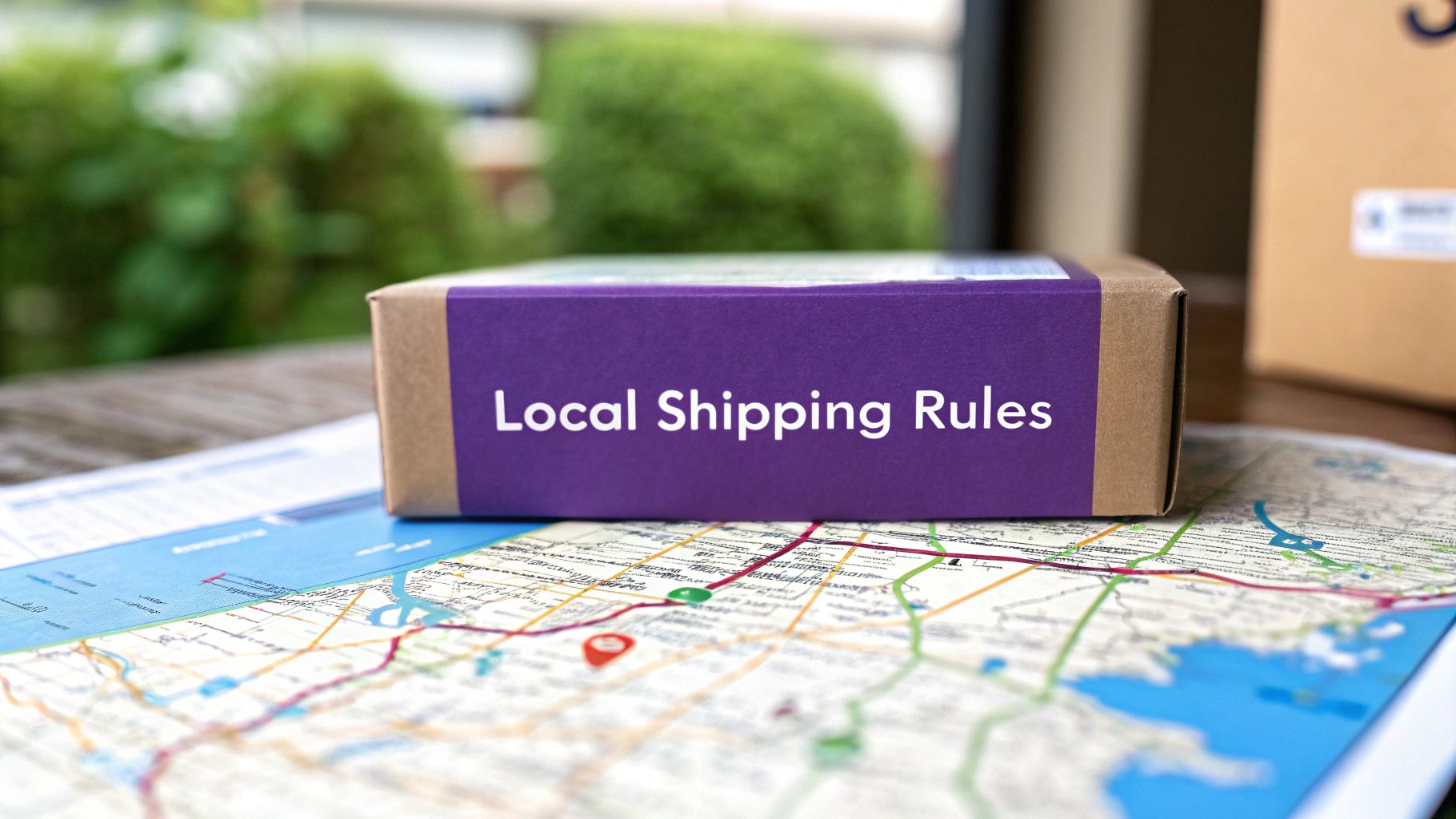
County-Level Shipping Restrictions: Why State Compliance Isn't Enough
Learn why county-level shipping restrictions matter and why relying on state compliance isn't enough to avoid risks and fines. Stay compliant locally!
Cody Y.
Updated on Sep 29, 2025
Thinking you’re in the clear just because you’ve checked the box on state-level shipping compliance? Think again. That’s a common—and often costly—mistake.
There's a whole other layer of rules hiding just beneath the surface: county-level shipping restrictions. Ignoring them leaves a dangerous "compliance gap," exposing your e-commerce business to fines, returned shipments, and frustrated customers you might not see coming.
The Hidden Risks of State-Only Shipping Compliance
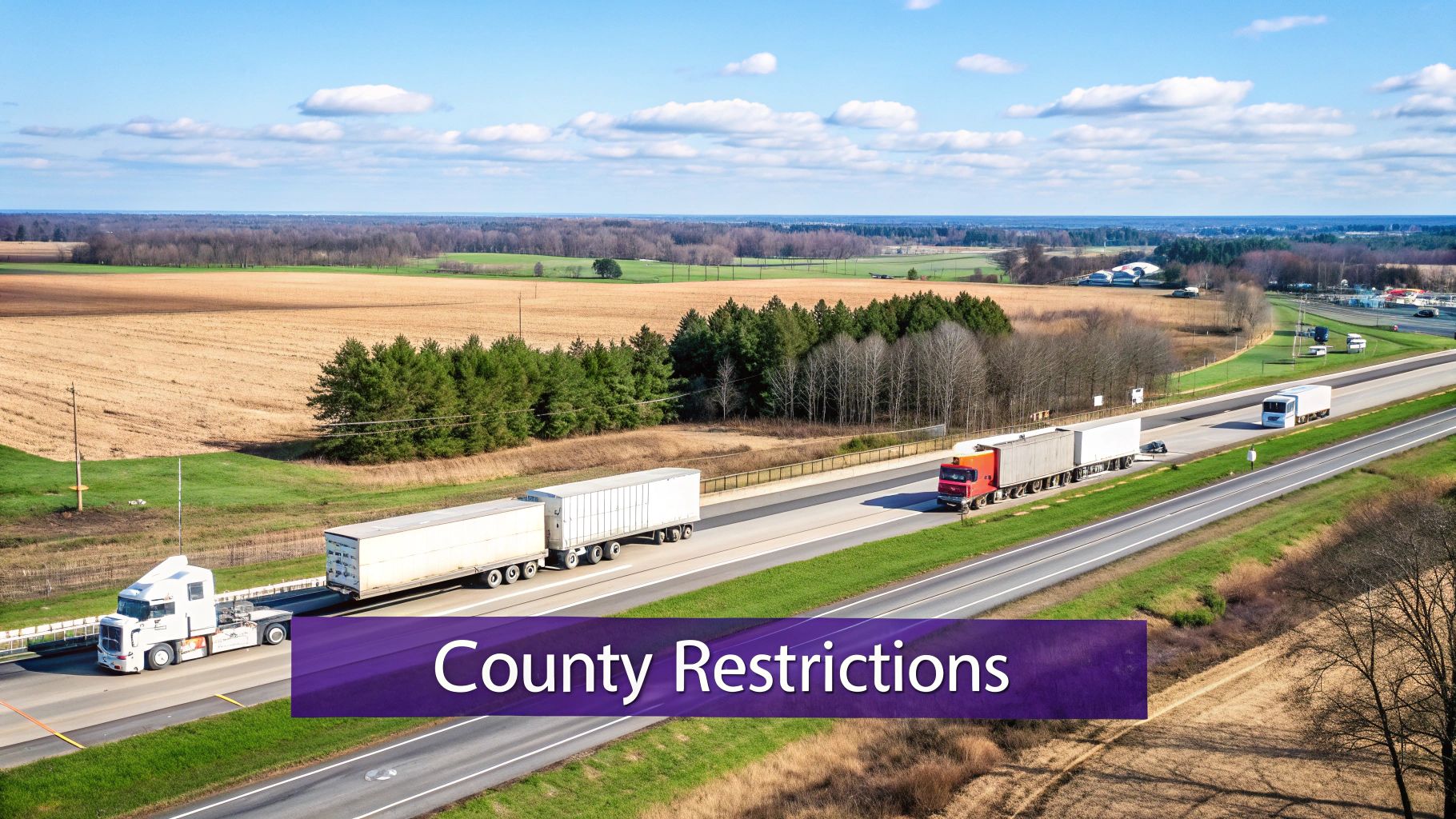
For many online stores, getting state-level shipping rules figured out feels like crossing the finish line. In reality, it’s just the first leg of the race. Assuming state approval gives you a free pass to ship anywhere in the country is a major blind spot.
Think of it like trying to navigate a bustling city using only a national highway map. Sure, you can find the major interstates, but you'll completely miss the one-way streets, local detours, and neighborhood-specific rules you actually need to reach your destination. That’s what happens when businesses ignore the fine print of county-level shipping laws.
The Financial and Logistical Fallout
Overlooking these granular rules isn't just a minor administrative headache. It carries real financial and logistical consequences. The gap between broad state laws and hyper-specific county rules is exactly where expensive problems are born.
A shipment that’s perfectly legal at the state border can be flagged, fined, or flat-out rejected the moment it enters a specific county. This triggers a painful chain reaction:
- Returned Shipments: This is the most immediate problem. You’re out the original shipping costs, and your inventory is stuck in transit instead of in a customer's hands.
- Hefty Fines: Counties have the authority to issue penalties for non-compliance, instantly turning a profitable sale into a net loss.
- Frustrated Customers: Nothing erodes trust faster than a failed delivery. This can permanently damage your brand's reputation, leading to bad reviews and lost future business.
Relying on state laws alone is like building a house on an incomplete foundation. Sooner or later, the structural gaps will cause significant problems that are far more expensive to fix than getting it right from the start.
Why Local Rules Matter
States often set the big-picture regulatory framework, but it's the counties that fill in the details with specific ordinances based on unique local needs.
For instance, California has over 50 counties, many with their own varying restrictions on things like diesel truck emissions near ports. Some counties enforce idling limits as short as five minutes to cut down on local air pollution—a detail you won’t find in the statewide law. According to the California Air Resources Board, these localized rules helped slash diesel particulate emissions in port areas by 30% between 2015 and 2023.
These local nuances are critical, and they're constantly evolving. You can learn more about how international shipping regulations are changing to get a sense of the bigger picture.
So, Why Do County Shipping Rules Even Exist?
County-level shipping restrictions can feel like just another frustrating hurdle, but they’re far from random. These rules are put in place to solve real, local problems that broad state laws simply can't address. Think of them as a community’s way of managing its own unique challenges, from protecting a local water source to keeping heavy trucks off a historic bridge.
A state law is like a general safety guideline for all highways in the state. A county rule, on the other hand, is the specific "No Trucks After 10 PM" sign on a quiet residential street. Both are important for safety, but only the local rule solves the immediate problem of late-night noise and traffic in that specific neighborhood.
These hyper-local regulations are driven by practical, on-the-ground needs that can change dramatically from one county line to the next.
What’s Driving These Local Rules?
Once you understand the "why" behind these rules, navigating them becomes a lot less confusing. While the specifics can vary wildly, most county-level shipping restrictions boil down to one of three core concerns.
-
Public Safety and Health: Some products, like certain agricultural chemicals or industrial materials, might be perfectly legal at the state level but pose a direct risk to a county’s specific water supply or a densely populated town. For example, a county might restrict the transport of flammable liquids through its historic downtown district.
-
Infrastructure and Traffic: A major state highway is built to handle heavy trucks, but that small county bridge built a century ago? Not so much. Counties often set vehicle weight limits or delivery curfews to prevent damage to local roads and bridges and to manage traffic on streets never designed for commercial overflow.
-
Environmental Protection: Local ecosystems are fragile. A county might ban the shipment of certain pesticides to protect a native bee population or restrict deliveries near a protected wetland. These rules are there to safeguard unique local resources that a statewide law would overlook.
The bottom line is that county-level shipping restrictions are a direct response to local conditions. A rule that seems totally unnecessary in a sprawling rural county might be absolutely critical in a compact, urban one right next door.
Finding Your Way Through the Maze of Local Ordinances
This is where the real headache begins for e-commerce businesses. Unlike state laws, which are centrally located and relatively easy to find, county rules are scattered across thousands of different jurisdictions.
Manually digging up these rules means sifting through a different set of sources for every single county you ship to—a task that quickly becomes unsustainable. You'd be looking in places like:
- County clerk or recorder websites
- Local transportation authority portals
- Public works department documents
- County-specific environmental agencies
This fragmentation is precisely why relying only on state-level compliance is a massive gamble. For instance, the state of Mississippi might allow direct-to-consumer wine shipments, but 31 of its 82 counties are "dry" and prohibit alcohol sales entirely. A shipment that’s perfectly legal on paper at the state level becomes an instant violation the moment it hits the delivery address, proving just how critical granular, localized compliance checks really are.
The Real-World Consequences of Ignoring County Rules
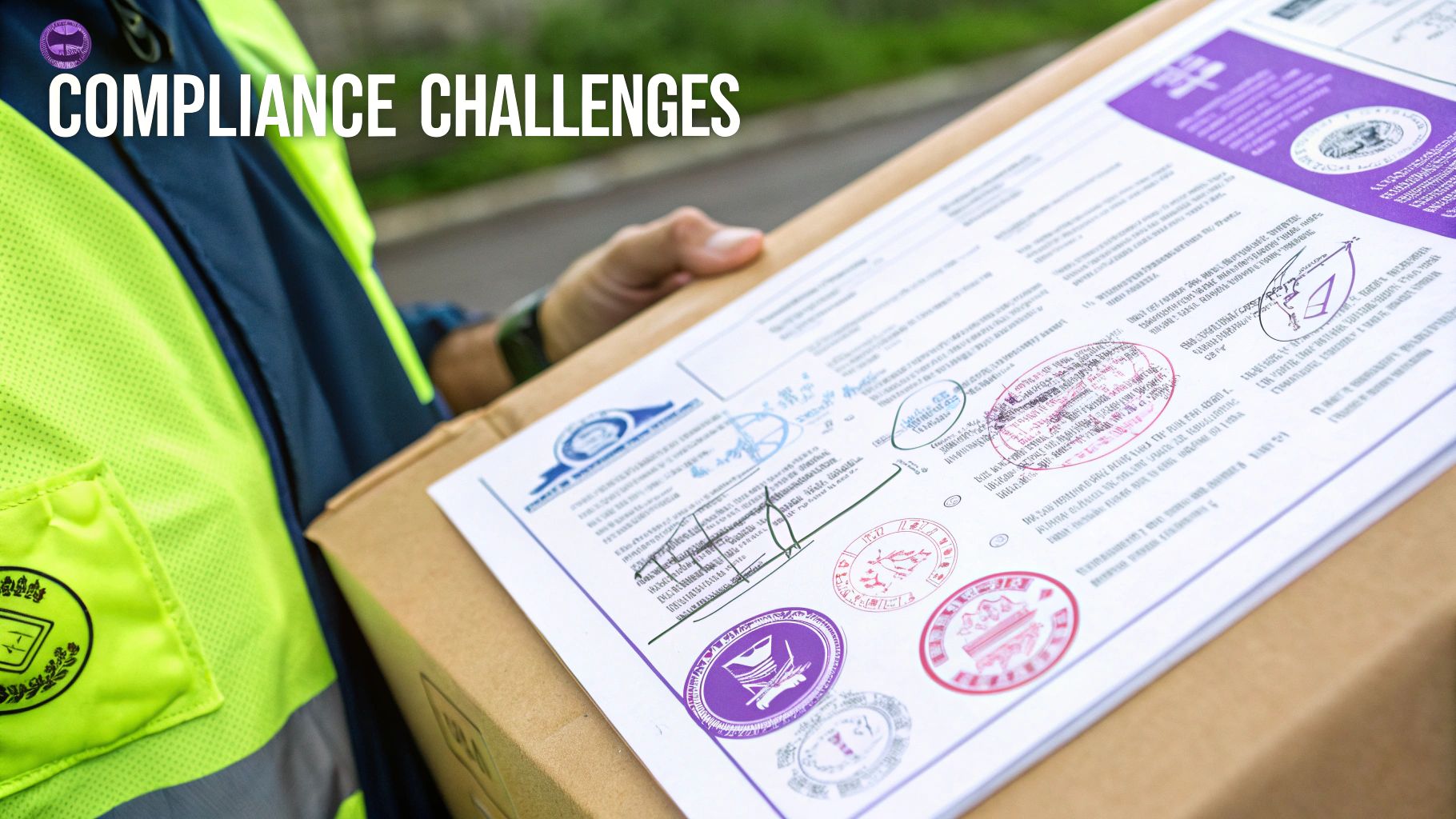
It’s easy to dismiss county rules as just minor details, but the real-world impact of ignoring them can be brutal. A single slip-up isn’t a small inconvenience; it can set off a painful chain reaction of financial hits, logistical chaos, and damage to your reputation. Honestly, ignoring these granular rules is a high-stakes bet where the house always wins.
Picture a scenario we see all the time: an online store ships a product that clears state-level checks with no issues. The package makes its way across the country and arrives in the right city. But the moment it hits the county line, a local ordinance flags it. The shipment is immediately rejected and sent right back to your warehouse.
Suddenly, you have a customer service meltdown on your hands. The customer is furious, your support team is scrambling, and you've just paid for shipping twice on a sale you never made. Now, imagine that happening with dozens of orders. You’re not just looking at a bad day; you're looking at a serious dent in your bottom line and your brand’s credibility.
Financial and Reputational Damage
The true cost of non-compliance adds up faster than you’d think, and it goes way beyond just shipping fees. When a package gets returned because you missed a county rule, the fallout is multifaceted.
- Direct Financial Losses: You're on the hook for return shipping fees, restocking costs, and sometimes, steep fines handed down by the county.
- Wasted Labor: Your team’s time gets eaten up processing returns and calming down angry customers instead of actually growing the business.
- Brand Erosion: A failed delivery is a broken promise. It doesn't take long for negative reviews to pop up, scaring away new customers and wrecking the trust you spent months building.
Overlooking county rules isn’t a calculated risk—it’s an operational blind spot. Each violation chips away at your profitability and the customer loyalty you've worked so hard to build.
Disrupting the Global Supply Chain
The headaches from these local rules don't just stay within U.S. borders; they send ripples across the entire global logistics network. When counties with major ports or transport hubs put their own specific regulations in place, they can create massive bottlenecks for international trade.
For example, data from 2023 showed that U.S. ports in counties with strict nighttime cargo handling rules experienced a 12% decrease in throughput volume. This led to an average delay of 18 hours per shipment, forcing global shipping lines to reroute vessels and contributing to a 3-5% spike in worldwide fuel consumption. You can discover more insights about the global freight market to see just how interconnected everything is.
This proves that county-level shipping restrictions aren't just minor speed bumps—they are critical business risks with far-reaching consequences. A single local ordinance can throw off schedules and inflate costs for companies thousands of miles away, showing exactly why state-level compliance is never the full picture.
Navigating the world of shipping compliance can feel like trying to solve one of those Russian nesting doll puzzles. You've got federal law as the biggest, outermost doll, setting the rules for the whole country. Inside that is the state-level doll, which adds its own layer of requirements.
But tucked deep inside is the smallest, most detailed doll—county law. And that's where things get tricky.
A county can always add more restrictive rules on top of what the state mandates, but it can never loosen a state or federal requirement. This layered system is precisely why following state law alone isn't enough to guarantee you're in the clear. You have to satisfy every single layer to be fully compliant.
The Hierarchy of Shipping Rules
This multi-layered approach isn't just to make your life harder; it allows broad regulations to be tailored for specific, local needs. A state might set a general policy for shipping agricultural products, but an individual county could add extra rules to protect a local water source from a specific pesticide. It’s all about local context.
The rules build on each other, getting more granular as you go from federal down to the local level.
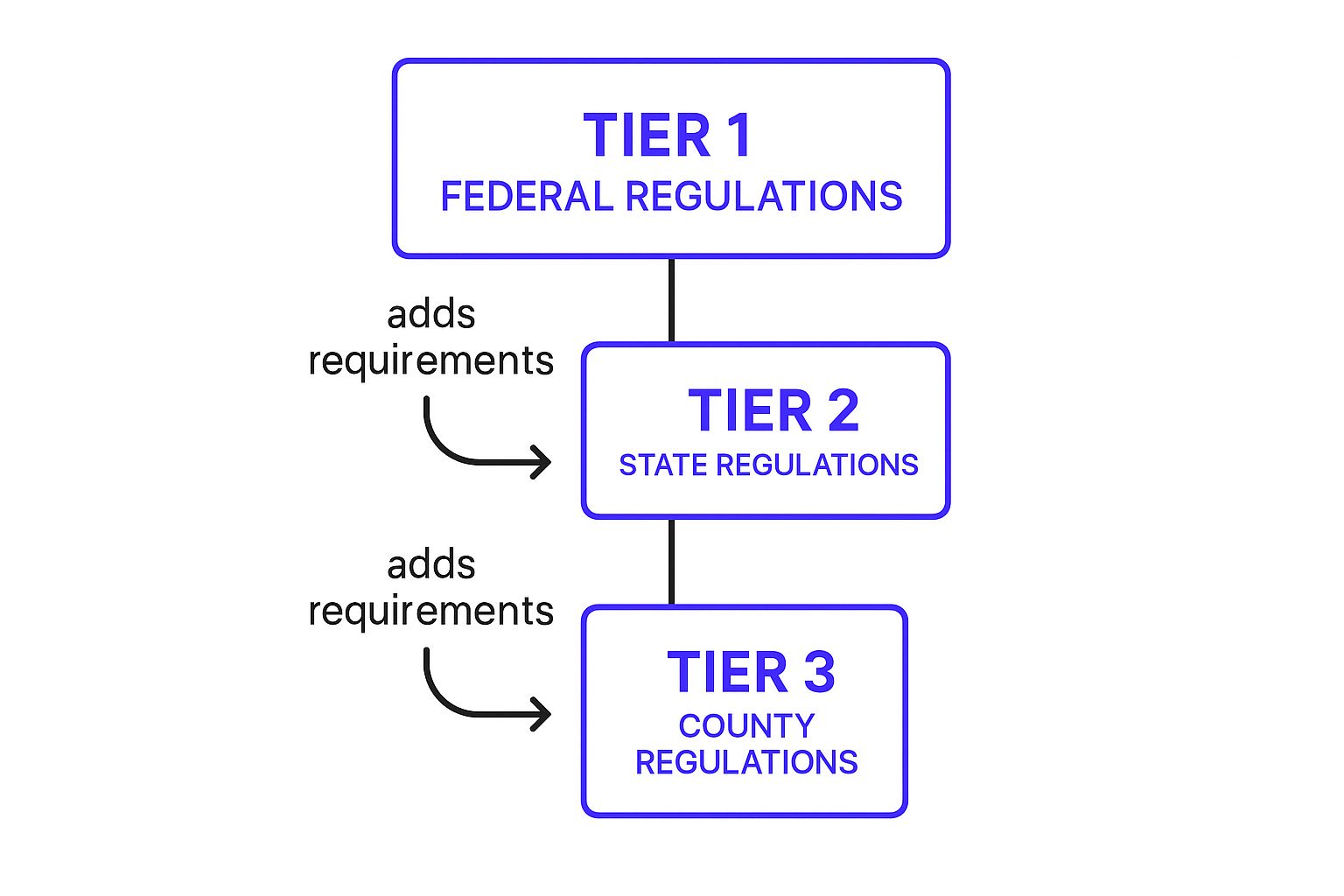
As you can see, compliance isn't a choice between different sets of rules. You have to follow them all. The deeper you go, the more specific the restrictions become.
A Practical Comparison: State vs. County Rules
Let's make this real. Imagine you're an online merchant selling wine. The difference between state and county oversight is what determines whether your delivery is a success or a costly violation.
State laws give you the baseline, but it's the county-level shipping restrictions that often have the final say.
To illustrate just how different these two layers can be, we've put together a quick comparison table. It shows why a shipment that seems perfectly legal at the state level can still be a major violation once it hits the county line.
State vs. County Shipping Restrictions at a Glance
| Compliance Level | Scope of Regulation | Example (Wine Shipments) | Enforcement Body | Common Penalty |
|---|---|---|---|---|
| State Level | Sets broad licensing, tax, and volume limits for the entire state. | A state law might permit wineries to ship up to 12 cases per consumer annually. | State Alcohol Beverage Control (ABC) Board | Fines, license suspension. |
| County Level | Enforces hyper-local rules, such as "dry" zones where alcohol sales are completely prohibited. | A "dry" county ordinance might ban all alcohol deliveries within its borders, overriding the state's allowance. | County Sheriff's Office or Local Authorities | Seizure of goods, criminal charges. |
This table makes it crystal clear: you can follow a state's rules to the letter and still end up breaking the law at the final destination.
This isn't just a hypothetical problem. We're seeing this play out right now with recent changes to U.S. federal regulations. In August 2025, the duty-free import threshold is being suspended, forcing international shippers to deal with new customs protocols at both state and county logistics hubs. As a result, some German postal services are actually pausing shipments to the U.S. through specific county postal routes until those local customs issues are ironed out.
Ultimately, understanding the specific location restrictions for every single destination isn't just a good idea—it's absolutely essential for staying compliant.
How to Automate Your Shipping Compliance
Trying to manually track shipping rules across thousands of federal, state, and county lines isn't just hard—it's practically impossible for any business trying to scale. With more than 3,000 counties in the U.S. alone, each with its own potential quirks, manual checks are a recipe for disaster.
This is the point where automation stops being a "nice to have" and becomes a core part of your business infrastructure. Forget hiring a team just to scan obscure county websites and legal PDFs. Automation is your real-time compliance gatekeeper, built right into the checkout process. It flips the script from reactive damage control to proactive, automated protection.
Your Digital Compliance Gatekeeper
Tools like Ship Restrict are designed to do the heavy lifting for you. They maintain a massive, constantly updated database of shipping regulations that connects directly to your store's checkout. For the customer, the process is completely invisible right up until a rule is triggered.
Here’s a quick look at how it works from the shopper's perspective:
- A customer finds what they want, adds it to their cart, and heads to checkout.
- They punch in their shipping address—state, city, and ZIP code.
- In that instant, the software cross-references the items in their cart against the specific rules for their exact location, right down to the county level.
If there's a restriction, the sale is blocked before any payment goes through. A costly shipping mistake is stopped before it can even happen. Your checkout just became an intelligent compliance checkpoint.
Below is a look at how Ship Restrict lets merchants build and manage these intricate rule sets from right inside their e-commerce dashboard.
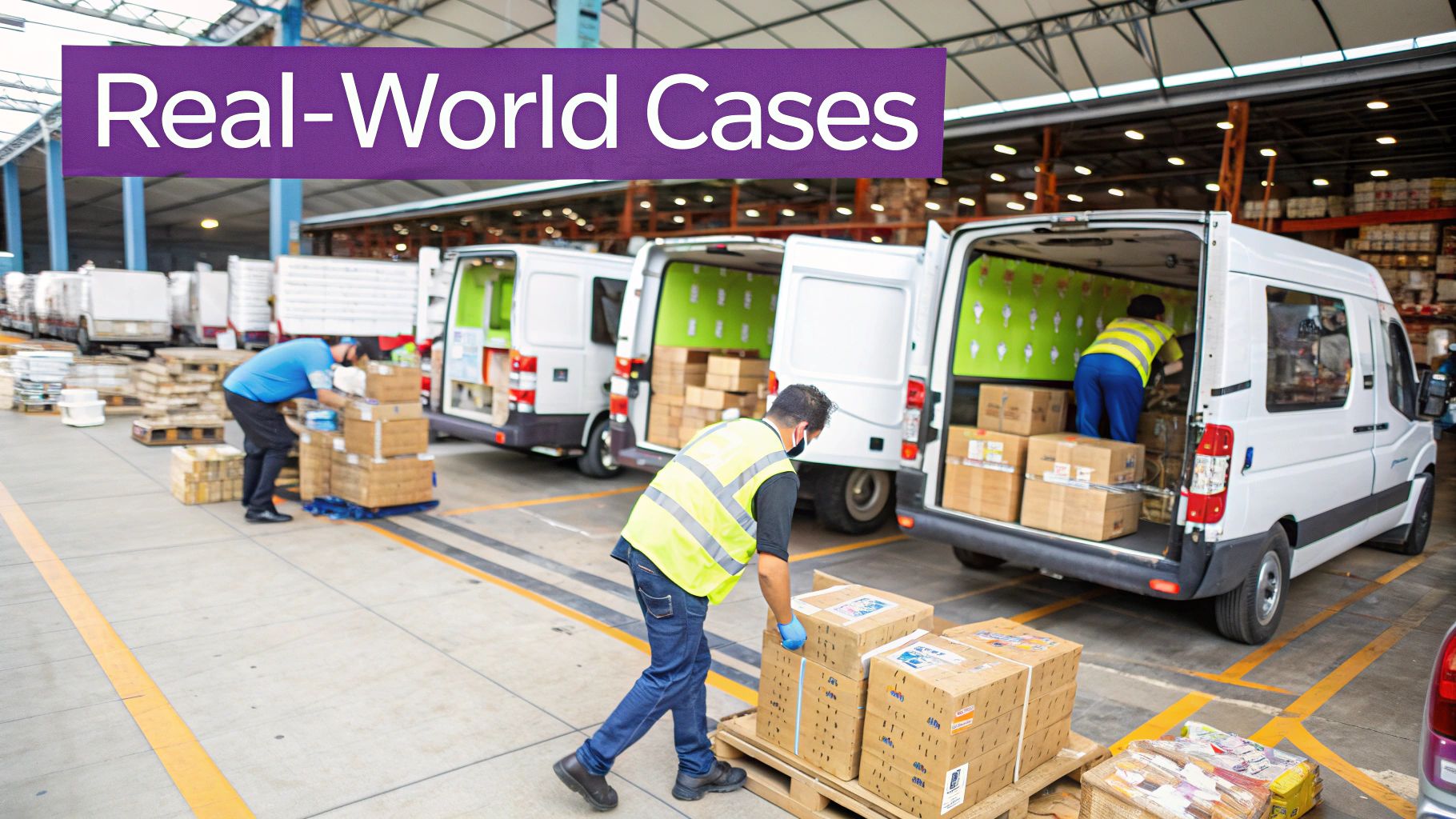
The interface makes it simple to create precise rules that apply to specific products and locations, ensuring every shipment is managed with granular control.
This level of precision is absolutely critical if you sell regulated goods. You can dive deeper into the setup process in our guide on automated shipping compliance for Woo Commerce stores.
Automation removes the "what if" from your shipping operations. It swaps guesswork and tedious manual labor for a dependable, scalable system that makes sure every single order follows all county-level shipping restrictions.
This proactive approach doesn’t just save you countless hours. It shields your business from the serious financial hits and reputational damage that come from non-compliance. It gives you the confidence to grow your market, knowing a powerful system is navigating the tangled web of local laws for you, turning a huge liability into a simple, automated process.
Building a Bulletproof Shipping Strategy
<iframe width="100%" style="aspect-ratio: 16 / 9;" src="https://www.youtube.com/embed/L4YreOtyqs8" frameborder="0" allow="autoplay; encrypted-media" allowfullscreen></iframe>If we boil everything down to a single takeaway, it's this: you have to shift your perspective. State-level compliance isn't the finish line; it's just the starting block.
The real secret to dodging five-figure fines and failed deliveries lies in navigating the messy, complicated web of county-level shipping restrictions. These are the hyper-local rules that govern that final mile to your customer's doorstep.
You have to be proactive. "I didn't know" is not a defense that holds up when a regulator comes knocking. For many businesses, untangling these local rules means bringing in outside help. Getting familiar with how a Third-Party Logistics (3PL) partner operates is a great first step if you're going that route.
But the only way to truly scale your operation without pulling your hair out is with automation. Think of it as your success checklist:
- Acknowledge State Laws Are Just the Start: Your work isn't done until you've dug into the local ordinances for every single place you ship.
- Automate to De-risk Operations: Use tools that enforce these granular rules right at checkout, stopping a violation before it ever becomes an order. Our guide on WooCommerce shipping restrictions by ZIP code breaks down exactly how to set this up.
When you embrace this detailed, ground-level approach, compliance stops being a threat. It becomes a powerful competitive advantage, ensuring every single box you send out gets where it's going—no drama, no returns, no fines.
Answering Your Toughest Shipping Compliance Questions
Diving into the world of multi-layered shipping regulations can feel like opening a can of worms—it often creates more questions than answers. When businesses first realize they need to worry about county-level shipping restrictions, a few common uncertainties always pop up.
Let's cut through the noise and give you some direct, clear answers. Getting these details right is the first step toward building a compliance strategy that actually protects your business from risk and financial hits.
What Kinds of Products Get Hit with County Rules?
While just about any product can fall under local scrutiny, some categories are almost always tangled up in granular county rules. These are typically products that regulators see as having a higher risk to public health, safety, or the local environment.
If you sell items in these categories, think of county-level compliance as non-negotiable. It’s essential. Products that constantly face these local-level roadblocks include:
- Alcohol and Tobacco: It’s common for states to have "dry" counties where the sale or delivery of booze and tobacco is completely banned, no matter what state law says.
- Firearms and Ammunition: Local ordinances can be much tougher than state laws, often dictating exactly what can (and can't) be shipped to a residential address.
- Agricultural Goods: These rules are all about stopping the spread of invasive species or plant diseases from one county to another.
- Hazardous Materials: This is a broad category covering everything from industrial chemicals to certain batteries, which may have very specific local rules for transport or disposal.
How Often Do County Shipping Rules Actually Change?
Here’s the part that trips everyone up: the sheer volatility of these rules. County regulations can—and often do—change multiple times a year. This constant state of flux is what makes trying to track everything manually a fool's errand for any growing business.
In the world of regulatory compliance, "I didn't know" is never a valid defense. You're on the hook for knowing and following every single law in every jurisdiction you ship to, no matter how often they get updated.
These changes can be triggered by a local vote, a new environmental study, or something as simple as temporary road construction. This is exactly why automation isn't just a nice-to-have; it’s the only way to ensure your compliance strategy can keep up.
Can I Really Be Fined for a Violation I Didn't Know About?
Yes. Absolutely. This is one of the harshest realities of shipping compliance. Regulators work under the assumption that it's your job to know and follow the law. Pleading ignorance about a specific county ordinance won't get you out of trouble.
The consequences are real, and they can be severe. We're talking hefty fines, having your products seized, and even getting your shipping licenses suspended. Every single violation of county-level shipping restrictions chips away at your bottom line and your brand's reputation.
Ready to stop worrying about compliance and start shipping with confidence? Ship Restrict automates your shipping rules right at checkout, blocking restricted orders before they turn into costly mistakes. See how Ship Restrict can protect your business today.

Cody Yurk
Founder and Lead Developer of ShipRestrict, helping e-commerce businesses navigate complex shipping regulations for regulated products. Ecommerce store owner turned developer.